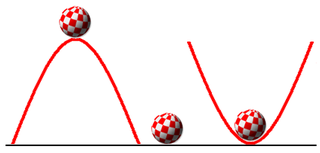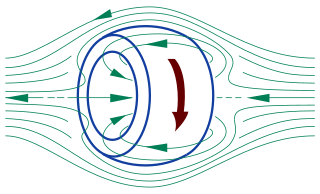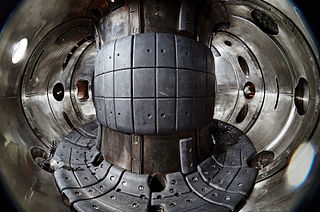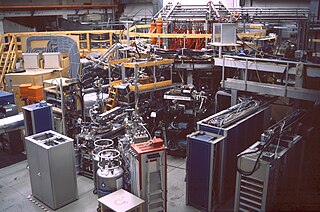Related Research Articles

The stability of a plasma is an important consideration in the study of plasma physics. When a system containing a plasma is at equilibrium, it is possible for certain parts of the plasma to be disturbed by small perturbative forces acting on it. The stability of the system determines if the perturbations will grow, oscillate, or be damped out.

The Large Helical Device (LHD) is a fusion research device in Toki, Gifu, Japan, belonging to the National Institute for Fusion Science. It is the second largest superconducting stellarator in the world, after the Wendelstein 7-X. The LHD employs a heliotron magnetic field originally developed in Japan.

A field-reversed configuration (FRC) is a type of plasma device studied as a means of producing nuclear fusion. It confines a plasma on closed magnetic field lines without a central penetration. In an FRC, the plasma has the form of a self-stable torus, similar to a smoke ring.
A dense plasma focus (DPF) is a type of plasma generating system originally developed as a fusion power device starting in the early 1960s. The system demonstrated scaling laws that suggested it would not be useful in the commercial power role, and since the 1980s it has been used primarily as a fusion teaching system, and as a source of neutrons and X-rays.
An edge-localized mode (“ELM”) is a disruptive instability occurring in the edge region of a tokamak plasma due to the quasi-periodic relaxation of a transport barrier previously formed during an L → H transition. This phenomenon was first observed in the ASDEX tokamak in 1981.
In toroidally confined fusion plasma experiments the term zonal flow means a plasma flow within a magnetic surface primarily in the poloidal direction. This usage is inspired by the analogy between the quasi-two-dimensional nature of large-scale atmospheric and oceanic flows, where zonal means latitudinal, and the similarly quasi-two-dimensional nature of low-frequency flows in a strongly magnetized plasma.
Ion cyclotron resonance is a phenomenon related to the movement of ions in a magnetic field. It is used for accelerating ions in a cyclotron, and for measuring the masses of an ionized analyte in mass spectrometry, particularly with Fourier transform ion cyclotron resonance mass spectrometers. It can also be used to follow the kinetics of chemical reactions in a dilute gas mixture, provided these involve charged species.
The Hannes Alfvén Prize is a prize established by the European Physical Society (EPS) Plasma Physics Division in 2000. The Prize is awarded annually by the European Physical Society at the EPS Conference on Plasma Physics for outstanding work in the field of plasma physics: "for achievements which have shaped the plasma physics field or are expected to do so in future."
The ballooning instability is a type of internal pressure-driven plasma instability usually seen in tokamak fusion power reactors or in space plasmas. It is important in fusion research as it determines a set of criteria for the maximum achievable plasma beta. The name refers to the shape and action of the instability, which acts like the elongations formed in a long balloon when it is squeezed. In literature, the structure of these elongations are commonly referred to as 'fingers'.

A ball-pen probe is a modified Langmuir probe used to measure the plasma potential in magnetized plasmas. The ball-pen probe balances the electron and ion saturation currents, so that its floating potential is equal to the plasma potential. Because electrons have a much smaller gyroradius than ions, a moving ceramic shield can be used to screen off an adjustable part of the electron current from the probe collector.

The COMPASS tokamak in Prague is the main experimental facility of Tokamak department of Institute of Plasma Physics of the Czech Academy of Sciences since 2006. It was designed in the 1980s in the British Culham Science Centre as a flexible research facility dedicated mostly to plasma physics studies in circular and D-shaped plasmas.

Sir Steven Charles Cowley is a British theoretical physicist and international authority on nuclear fusion and astrophysical plasmas. He has served as director of the United States Department of Energy (DOE) Princeton Plasma Physics Laboratory (PPPL) since 1 July 2018. Previously he served as president of Corpus Christi College, Oxford, since October 2016. and head of the EURATOM / CCFE Fusion Association and chief executive officer of the United Kingdom Atomic Energy Authority (UKAEA).
Hartmut Zohm is a German plasma physicist who is known for his work on the ASDEX Upgrade machine. He received the 2014 John Dawson Award and the 2016 Hannes Alfvén Prize for successfully demonstrating that neoclassical tearing modes in tokamaks can be stabilized by electron cyclotron resonance heating, which is an important design consideration for pushing the performance limit of the ITER.
Dmitri Dmitriyevich Ryutov is a Russian theoretical plasma physicist.
Jürgen Meyer-ter-Vehn is a German theoretical physicist who specializes in laser-plasma interactions at the Max Planck Institute for Quantum Optics. He published under the name Meyer until 1973.
Kunioki Mima is a Japanese plasma physicist. He is known for his contributions to the theory of turbulent transport in plasmas, and in particular the derivation of the Hasegawa–Mima equation in 1977, which won him the 2011 Hannes Alfvén Prize.
Patrick Henry Diamond is an American theoretical plasma physicist. He is currently a professor at the University of California, San Diego, and a director of the Fusion Theory Institute at the National Fusion Research Institute in Daejeon, South Korea, where the KSTAR Tokamak is operated.
Sergei Vladimirovich Bulanov, is a Russian plasma physicist. He received the 2016 Hannes Alfvén Prize for "contributions to the development of large-scale next-step devices in high-temperature plasma physics research".
Friedrich E. Wagner is a German physicist and emeritus professor who specializes in plasma physics. He was known to have discovered the high-confinement mode of magnetic confinement in fusion plasmas while working at the ASDEX tokamak in 1982. For this discovery and his subsequent contributions to fusion research, was awarded the John Dawson Award in 1987, the Hannes Alfvén Prize in 2007 and the Stern–Gerlach Medal in 2009.

Wendelstein 7-AS was an experimental stellarator which was in operation from 1988 to 2002 by the Max Planck Institute for Plasma Physics (IPP) in Garching. It was the first of a new class of advanced stellarators with modular coils, designed with the goal of developing a nuclear fusion reactor to generate electricity. The experiment was succeeded by Wendelstein 7-X, which began construction in Greifswald in 2002, was completed in 2014 and started operation in December 2015. Unlike its predecessor, the goal of the Wendelstein 7-X experiment is to investigate the suitability of components designed for a future fusion reactor.
References
- ↑ "The Laboratory for Complex Energy Processes". Institute of Advanced Energy, Kyoto University. Archived from the original on 2016-04-17.
- ↑ Okada, H.; Kobayashi, S.; Nagasaki, K.; Mizuuchi, T.; Yamamoto, S.; Motojima, G.; Watanabe, S.; Mukai, K.; Mihara, S.; Kowada, Y.; Hosaka, K.; Matsuyama, A.; Nakamura, Y.; Hanatani, K.; Nishino, N.; Nakashima, Y.; Nagaoka, K.; Mutoh, T.; Suzuki, Y.; Yokoyama, M.; Konoshima, S.; Kondo, K.; Sano, F. "Configuration Control Experiment in Heliotron J" (PDF). Retrieved 25 September 2018.
- ↑ Obiki, T.; Mizuuchi, T.; Nagasaki, K.; Okada, H.; Besshou, S.; Sano, F.; Kondo, K.; Liu, Y.; Nakamura, Y.; Hanatani, K.; Nakasuga, M.; Wakatani, M.; Hamada, T.; Manabe, Y.; Shidara, H.; Yamagishi, O.; Aizawa, K.; Ang, W. L.; Ikeda, Y. I.; Kawazome, Y.; Kobayashi, T.; Maeno, S.; Takamiya, T.; Takeda, M.; Tomiyama, K.; Ijiri, Y.; Senju, T.; Yaguchi, K.; Sakamoto, K.; Toshi, K.; Shibano, M. (2000), First Plasmas in Heliotron J, Sorrento, Italy: IAEA, retrieved 2018-09-25
- ↑ Obiki, T; Sano, F; Wakatani, M; Kondo, K; Mizuuchi, T; Hanatani, K; Nakamura, Y; Nagasaki, K; Okada, H; Nakasuga, M; Besshou, S (2000). "Goals and status of Heliotron J". Plasma Physics and Controlled Fusion. 42 (11): 1151–1164. doi:10.1088/0741-3335/42/11/302. ISSN 0741-3335.
| | This nuclear physics or atomic physics–related article is a stub. You can help Wikipedia by expanding it. |